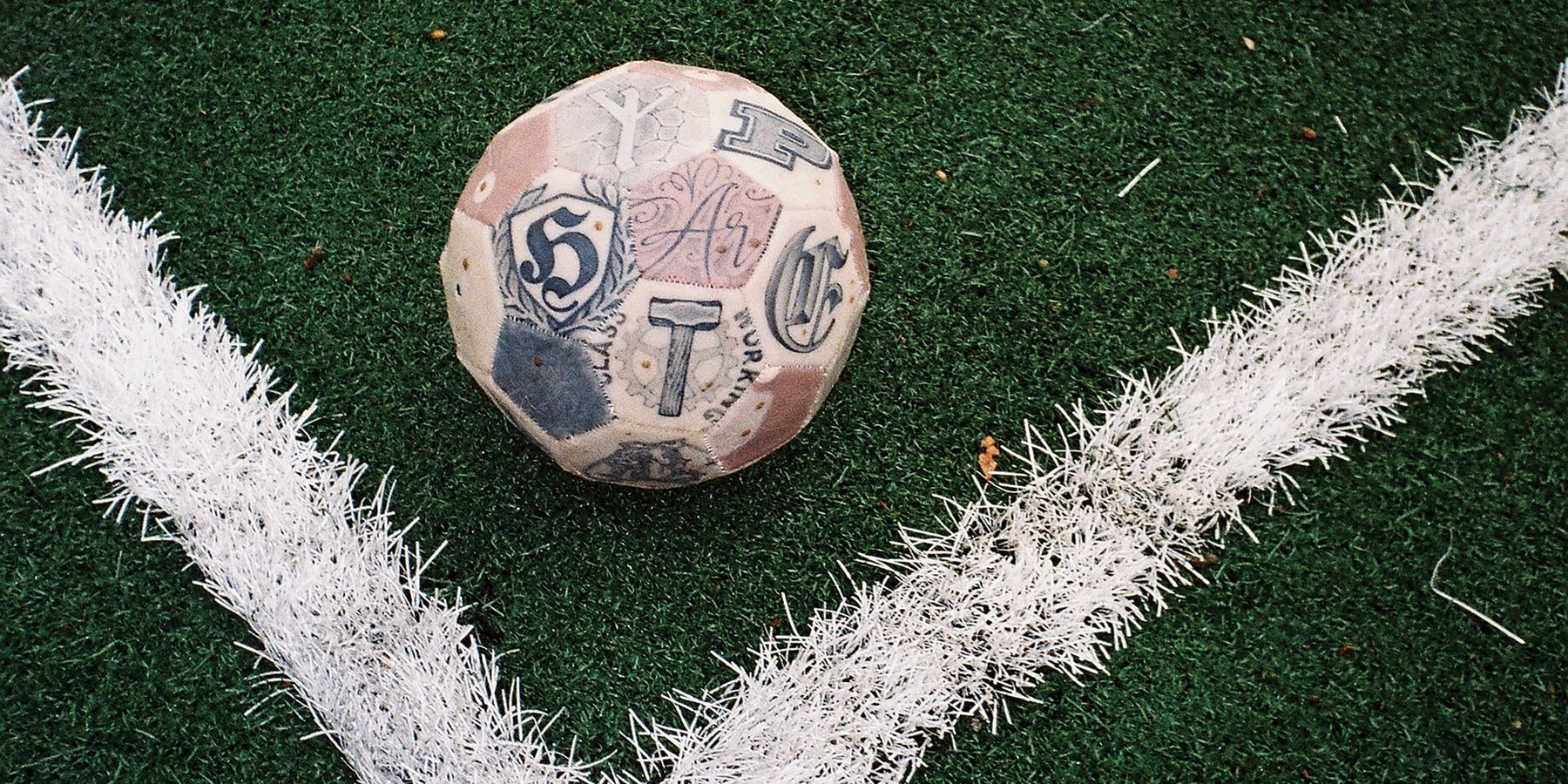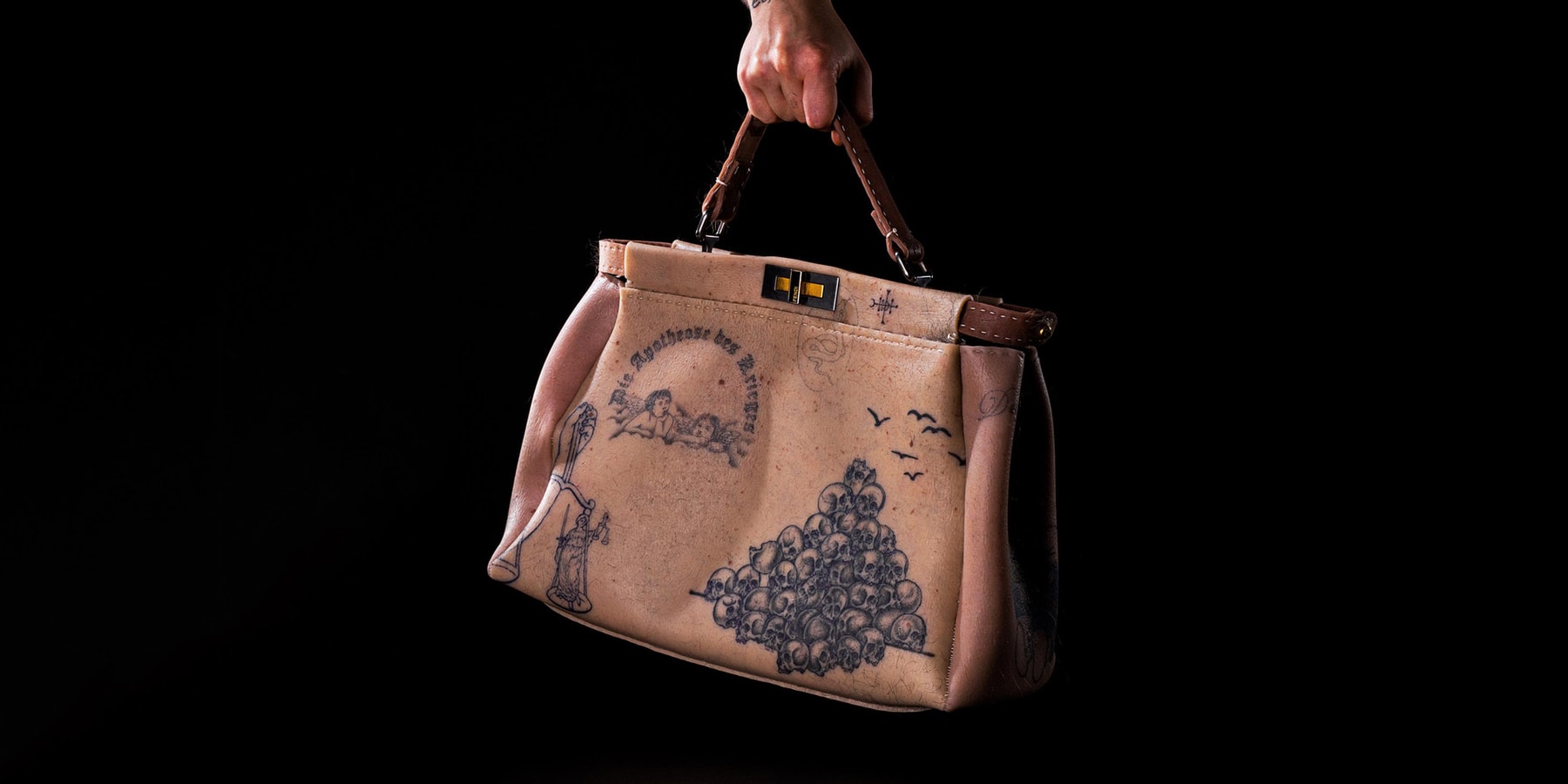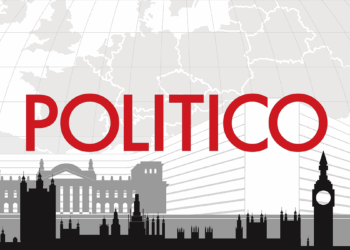
 PEN & PAPER: HERMAN DEVIASHINThe past, present and future of tattooing, envisioned by the Russian artist.By Erin Ikeuchi
PEN & PAPER: HERMAN DEVIASHINThe past, present and future of tattooing, envisioned by the Russian artist.By Erin Ikeuchi
Herman Deviashin is rewriting the tattoo playbook. From resurrecting Russia’s forgotten ink traditions to AR tattooing and designing body art for one of gaming’s most notorious villains, the artist is pushing the needle way past the edge.
Born in Tyumen, Siberia, Deviashin got his start in graffiti, though the instinct to mark eventually moved off the walls and onto skin. His journey has taken him to Berlin, Moscow and most recently, Barcelona, where he’s based. There, he’s developed a hybrid practice that fuses tattooing with sculpture, creating hyperrealistic “skin” pieces etched in his signature fine-line style. Drawing on Siberian ironic conceptualism, his work balances humor, horror and a tender kind of absurdity: Sisyphus stuck on a treadmill, kids dancing around mushroom clouds and flesh-clad teddy bears with nipples for eyes, stitched with a precise and affectionate hand.
In 2023, Deviashin was tapped as a contributor for Call of Duty: Modern Warfare III, with Vladimir Makarov donning custom onscreen pieces. Last year, he was the subject of “The Circle,” a documentary short that captures the making of the world’s first AR tattoo — an experiment born out of creative burnout and the uneasy marriage between tattooing traditions and emerging technologies.
When he’s not behind the needle, Deviashin co-runs Russia’s first tattoo archive, @russiantattoohistory, alongside Sasha Morozov. Started in 2020, the project documents tattoos across the country, aiming to showcase the lesser known world of Russian ink culture, beyond the widely recognized Soviet prison tattoos. “I can confidently say we’re the world’s only experts in Russian tattoo history,” he tells Hypeart. “We passed an examination by the Museum of Gulag History.” More than a mere database, the archive serves as a lens onto subcultures, identity and the way ink maps memory.
For this edition of Pen & Paper we spoke with Deviashin about how the past, present and future of tattooing. Read on for the full interview.
“Tattooing for a lifetime could leave more questions than answers. That’s why I’m always interested in finding new mediums for my creativity.”
What were your first interactions with tattoos, and how did they lead you to become a tattoo artist?
My entry into tattooing was quite conscious. I remember being hypnotized by the tattoos of fellow travelers on buses or trains. It was the late ‘90s — an unstable time in Russia with devaluation, the Chechen war and the heroin epidemic. Amid the chaos, there were presidential amnesties, so many people with prison tattoos were visible in society.
At the time, I didn’t think much about tattoos for myself or that I would ever tattoo others. I had been drawing graffiti for a while, but I lost interest in that hobby, and wanted to find a new medium for myself. Tattooing became that medium.
How would you describe your practice today?
Oh, that’s a very difficult question to answer. I understand that tattooing for a lifetime could leave more questions than answers. That’s why I’m always interested in finding new mediums for my creativity.
Last year, I tried to enroll in Alexander Sokurov’s directing course in Armenia. He’s probably the only working Russian director of art-house cinema who isn’t afraid to express his life position — even if it means arguing with the president, which usually doesn’t end well. Unfortunately, the course was canceled, but my desire to direct only grew after meeting Sokurov.
Can you tell us about your Russian tattoo archival project?
Although I always paid attention to prison tattoos, I never romanticized them. In my childhood, there were two parallel worlds: the familiar society — family, school — and then there was the street, which was saturated with prison culture. Some of my peers were involved in robbery to collect money for people in prison. All problems were solved by “shooters”: 100-200 people, mimicking prison concepts and the hierarchical system. During one of these shootings, someone brought a crossbow and killed a guy with a shot to the chest. I hated it.
Now, as a recognized tattoo artist in Russia with my own signature, many of my friends have started saying I have a “prison style” since they look like “blue” tattoos. It became clear to me that we needed to understand what Russian tattooing actually is, beyond khokhloma or neo-Slavic motifs, but within its true historical context. How did the Russian criminal tattoo appear? That’s how the project started.
Last year, you completed the world’s first AR tattoo and the process was captured in “The Circle.” What was the impetus for this?
I have a friend from my graffiti days, Andrey Drobitko, who is now a well-known AR software developer. Their app, SketchAR, is a drawing tool for flat surfaces – walls or paper – using HoloLens glasses or a smartphone. I was fascinated by its possibilities for 3D objects. This imperfect technology sparked something new for me: a sense that the process held more questions than answers.
Andrey was unsure whether or not this experiment would work, but three years ago, he agreed to try it. I gathered a team of enthusiasts – Evgeny Bakirov, Andrey Krauzov and Mikhail Novitsky – who shared my curiosity. Through this, Bakirov, the director, saw both my inner creative crisis and search, and it became the film’s logical conclusion.
“You no longer have to endure pain, though pain has always been a part of tattooing. It goes against the instinct of self-preservation; it turns into a desire to beautify oneself, which, to me, is less compelling.”
Are there other ways you’ve seen or hope to see tattooing intersect with emerging technologies?
Tattooing is definitely evolving. The barrier to entry is now very low. It’s moved from being an archaic ritual to a technological process. You no longer have to endure pain, though pain has always been a part of tattooing. It goes against the instinct of self-preservation; it turns into a desire to beautify oneself, which, to me, is less compelling.
I also see a future where robotization plays a role in tattooing. Perhaps one day, tattoos could be applied without the direct interaction between artist and client, making the process more impersonal. However, the connection between the artist and the client is important. I enjoy interacting with people from different walks of life, and sometimes that even turns into friendship.
I’m not opposed to these technological advancements. I watch with interest as tattooing becomes a tool for artists, rather than just craftsmen. New textures and a complete lack of rules and boundaries are emerging in the field.
There is a temporal aspect to your work as you look into both the past and future of tattooing. Are there any particular art periods that have influenced your practice?
Honoring the past and imagining the future so you can understand the present – I think that’s what art is about. Lately, I’ve been questioning the nature of time itself: whether it really moves in just one direction. Of course, there are always artists and works from different periods that inspire me. It’s not just visual art — literature and music provide me with greater space for visualization. These works change with me over time; though the text remains the same, like good wine, its meaning deepens, revealing something new with each reading.
“For me, these works reflect the uniqueness of human skin — the marks of life, scars and the history they carry.”
What sparked your interest in tattooing as a sculptural form? What was your first project in this medium?
My interest in tattooing as a sculptural form developed gradually, working through different materials like porcelain and calfskin, and creating scans for exhibitions. My first real encounter with this medium was while I was working with SFX specialists to recreate tattoo textures for Husky’s “Never Ever” music video. I became very fussy about the details in my work, so I created a technology that allowed me to reproduce the tattoo’s texture exactly as it appears on skin, including the blurriness of the lines.
By tattooing on silicone and transferring the designs onto human skin, I discovered a sculptural material that connected artisanal tattooing with contemporary art. I trained with SFX makeup artist Daria Rykova, and now I can manage the process on my own — from sculptural modeling in plasticine to mold casting and silicone integration with realistic textures, like moles and hair. For me, these works reflect the uniqueness of human skin — the marks of life, scars and the history they carry.
What themes underlie your work?
There is certainly a residue of childhood memory in my work, layered with the experiences I’ve gained over the years. In my work, I see the irony of the ‘90s: the Russian mentality and the concept of avos, the belief that against all odds, everything will turn out fine.
As someone born during the collapse of the USSR and raised in an open country, I gravitate toward everything new and Western. I like integrating pop culture into Russian contexts, often reflecting on themes like Oscar Wilde’s “Salomé,” but reinterpreting them in today’s world — showing John the Baptist’s head on a modern family’s dinner table.
Now that I live in Spain, I find myself inspired by the cultural nuances of Catalonia. I like exploring human vices and weaknesses, which is partly a reflection of myself. I’m fascinated by how people interpret my sketches, and the incongruences between their interpretations and my intentions.
“…toys often serve as protectors from the bad things around us — but as we grow, we forget about these things. My teddies are toys for adults, serving as a reflection of childhood trauma.”
Your teddy bear sculptures reflect ideas of trauma and childhood innocence in equal measure. How did this series come about? Can you talk about the decision to include elements such as hair, piercings and moles?
For many years, my mother sewed classic teddy bears and often gifted them to people she loves. Her sincerity in this inspired me to create my own bears out of silicone and synthetic mesh.
Sure, the image is linked to childhood – toys often serve as protectors from the bad things around us — but as we grow, we forget about these things. My teddies are toys for adults, serving as a reflection of childhood trauma. Each bear has its own character, with scars, tattoos and other elements that tell a story. The final touch is painting thin veins over the tattoos, and adding small details to enhance the realism.
How do you envision tattooing blending into the more conventional fine art world?
Tattooing can absolutely blend into the fine art world, although a few years ago, I didn’t know if it was possible. Now, I see how it can be done authentically. Tattooing can be preserved in the layers of history, not just through photographs or embalming.
I’m also interested in how tattooing can serve a scientific purpose. We’ve started a project with a team of neuroscientists to study pain through tattooing, which could be important for understanding phantom pain and the effects that tattooing has on the human body. We’ve even registered our study with the world’s ethics committee.

Are there any upcoming projects we should be on the lookout for?
I’m looking forward to consulting and creating tattoos for some films and movie projects. It’s something I’m passionate about because once I notice poorly done tattoos onscreen, I can’t unsee them.
I proposed an exhibition at Han Shinko’s SURR gallery in LA, which would be my first solo exhibition in the U.S. For the last nine years, I’ve been creating silhouettes of tattooed people with Ukrainian and Russian tattoo artists, so I’m looking for a venue in Europe to present a project related to war and peace. Due to the sensitive nature of the current conflict, it’s been impossible to present the work, but I will keep trying, as it’s important to restore trust between the people of this project.
I’ll also be working with Fabio Viale, who creates antique replicas with tattoos. He promised to teach me how to work with marble, and as someone from Russia, the opportunity to become an apprentice to an Italian sculptor steeped in the colossal history of art is a chance I can’t pass up.
I’m an adventurous person, and I don’t know where I’ll be in a year. We’ll see.
Photography by Herman Deviashin and Evgeny Bakirov. All artwork courtesy of the artist for Hypeart.
The post Pen & Paper: Herman Deviashin appeared first on Hypebeast.




